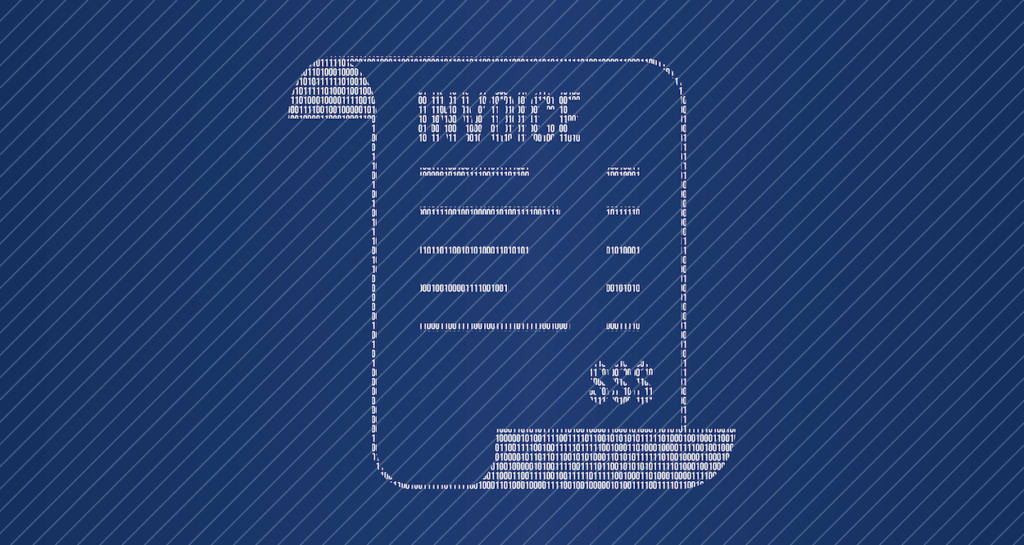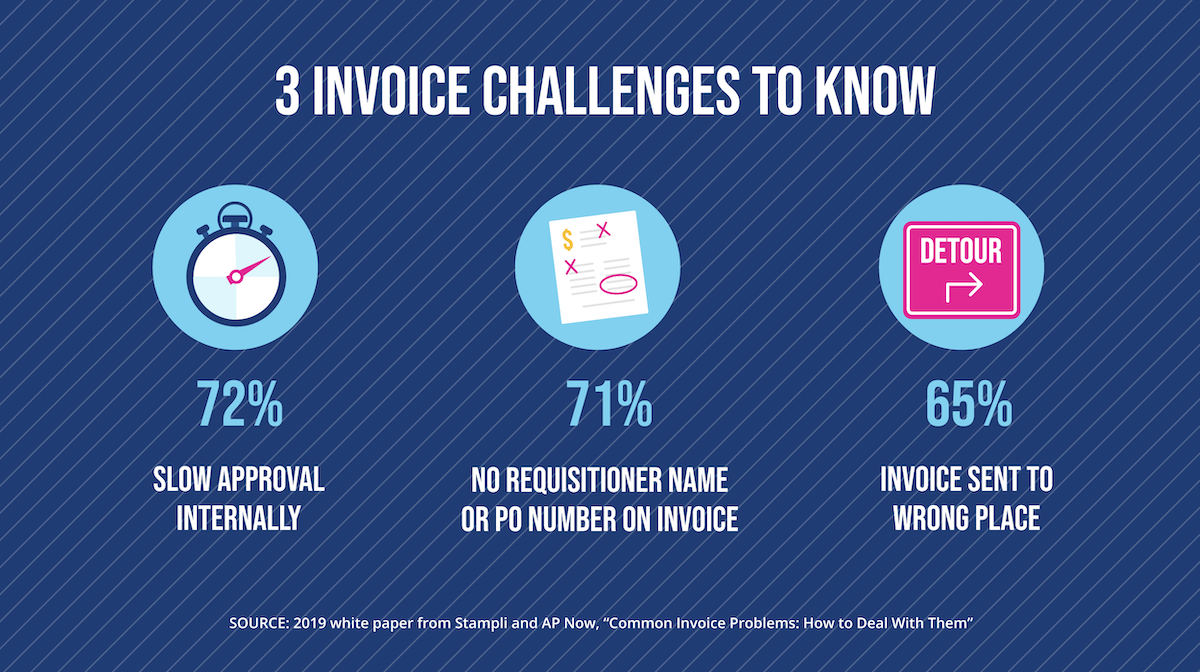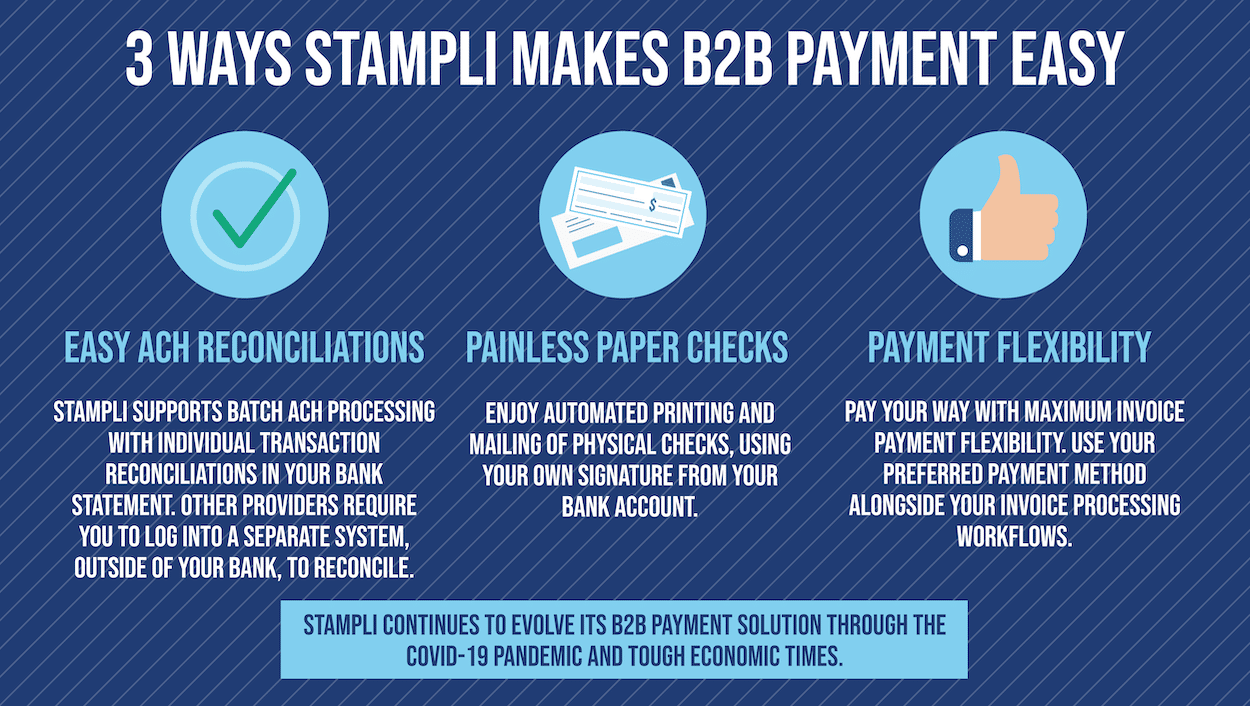The Complete Guide to Handling Electronic Invoices and B2B Payments

With the number of electronic invoices only logical to increase as business gradually continues to trend toward eventual paperless operations, it’s as good a point as any for any business representative who’s held out on learning how to receive, process, and pay electronic invoices to get up to speed. Join us as we go through each step.
Receiving Electronic Invoices

Not every business has a detailed workflow on what to do every time an invoice arrives in the email inbox of one of its accounts payable representatives. Having a good plan from the start and knowing what to expect before an electronic invoice arrives can help ensure that AP’s work goes smoothly.
The Basics of Electronic Invoices
These days, sending an electronic invoice doesn’t have to be anything too sophisticated. It doesn’t even have to cost your vendor anything to do it.
Creating an electronic invoice can be as simple as opening a blank spreadsheet in Google Drive, filling in a few data fields to signify goods or services provided, the amount owed for them, and when payment is due. The invoice can then be emailed over, still within Google Drive, as a PDF attachment. Vendors can simply email invoices to their customers.
Of course, free solutions have their limitations, so some vendors might look to different paid solutions, with the right one depending on whether they’re a freelancer, small business, or major corporation. The advantage of using paid software to send invoices, rather than just crunching out something through Google Drive, is that it can integrate with bookkeeping and bill payment, offering greater functionality in general. It’s also better for accounts payable departments on the receiving end.
That said, AP departments with good accounts payable automation software needn’t worry how an electronic invoice reaches them, because best-in-breed AP automation software can adapt.
Pros and Cons of Electronic Invoices
It can cost as much as $40 to process a single invoice, with weeks and sometimes months needed for approval with paper invoices. The electronic invoice and payment process can move quicker, though, for multiple reasons. There isn’t any tedious wait for an invoice to arrive via snail mail. And the invoice is also likely to process quicker, not needing to be scanned once it arrives.
On the down side, electronic invoices can present security concerns with “287 data breaches in 2019 involving payment card and other types of data such as email addresses and other personal information” and U.S. data breaches increasing 17% overall to 1,473 that year, according to the San Diego non-profit Identity Theft Resource Center.
For this reason, any business that accepts electronic invoices will want to have controls in place, the kind that can come from having invoice processing software designed with maximum controls and security features in mind.
Why to Receive Electronic Invoices Digitally
Some businesses might cling to old practices with their payment processing, even if their vendors are doing everything they can to nudge them to the future whenever they send invoices in.
The businesses might print electronic invoices out and process them by hand, creating a manual process themselves. Anyone who does this, though, is adding an unnecessary step and also sending a signal about their company.
Processing Electronic Invoices Digitally

Once a company has an electronic invoice in hand, what next is there to do? The next step is to have a clear plan on how to digitally process invoices.
Getting the Invoice into Your Accounting System
Some companies still have their accounts payable personnel manually using a 10-key pad at their desktop computer to input the data from every invoice into an accounting system. Others might go through a roundabout process of printing out a digital invoice and then using optical character recognition, or OCR software to scan it into an accounting system.
Needless to say, there are better approaches for getting an invoice into an accounting system than either manually inputting it or using OCR that isn’t attached to an automation solution. AP automation software can capture and convert invoices as soon as they arrive in email inboxes. One solution provider that does this is Stampli where “invoices and bills are automatically captured into the platform and immediately available for processing.”
There’s no reason in the year 2020 for AP staff to still be wasting time on invoice data entry — a universally-loathed task in accounting — when this task can be automated, allowing staff to focus on more high-value duties, such as data analysis and fraud prevention, or other value-added projects.
A Digital Processing Workflow
AP automation software can also come with adaptable workflows that align to your invoice and payment processes, which is useful for helping determine where an invoice needs to be sent for approval. After all, just because an invoice arrives in electronic form doesn’t mean that there will be any plan on which approvers will need to see it or which documents it will need to be matched with to prove that the goods or services were agreed to and received.
Workflows can help set a course so that the moment an electronic invoice reaches the inbox of an accounts payable clerk or whoever else might be handling it, it’s already on its course from procurement to payment. There’s no reinventing the wheel, so to speak, each time a new digital invoice comes in. There’s just a tried and true, scalable process.
Using Digital Invoices (and Automation) to Decrease AP Approval Times
Invoice approval times can drag for weeks when conducted manually. In fact, 72% of respondents experienced slow internal approval in a survey referenced in a 2019 white paper “Common Invoice Problems: How to Deal With Them” from Stampli and AP Now. That same survey noted that 65% of respondents had an invoice sent to the wrong place or person and 71% got invoices missing purchase order numbers or requisitioner names.
A slow electronic invoice and payment approvals can stem from getting a paper invoice in front of high-level decision makers or remembering when deadlines loom for invoice payment. With many invoices on 15-day or 30-day or 60-day payment cycles, it can be easy to forget when things are due. Unfortunately, this can also lead to companies missing out on early payment discounts from their vendors and even getting hit with late fees.
AP automation software such as Stampli’s, though, provides automatic notifications and approval reminders, making it so that the electronic invoice and payment cycle rapidly accelerates.
Issuing Electronic Payments

Once an electronic invoice has been received and processed, it can be cleared for payment. Here’s what to expect when issuing electronic payments.
How Long Electronic Invoice Payment Takes
The time it takes to make an electronic payment often has less to do with technology and more to do with negotiable agreements between businesses and their vendors.
Some vendors incentivize early payment of the invoice by agreeing to waive a portion of the final cost, often 2-3 percent. For businesses that process large numbers of invoices each month, getting workflows and processes in place to guarantee that every last early payment discount is received is vital.
That said, it’s worth noting that payment can move a little quicker with electronic invoices rather than paper ones. This is because electronic invoices can have payment links and portals included, making payment a one-stop shop for businesses.
Beyond this, the time it takes to make a payment on an electronic invoice really depends on which way businesses choose to pay that invoice. Should they send a paper check, it’s however long the mail needs. If they decide on Automated Clearing House, or ACH payments, that can take 3 to 5 days. Wire transfers are quicker, albeit with higher fees and typically are only used for high-value or international payments.
Common Payment Methods
For B2B, electronic invoices can be paid in a variety of ways, including ACH, wire transfer, and cards. In general, electronic payments have been on the rise, with well over half of all B2B payments being made electronically.
When it comes to B2C payment methods, they too are evolving with trends toward mobile, contactless, and real-time payments as a result of the COVID-19 pandemic and other factors. eMarketer noted that about a third of all smartphone owners are expected to make proximity mobile payments in 2023. In 2020, credit card companies have seen a sharp rise in contactless payment options, according to The Points Guy, while the Payments Journal noted last year that nearly all banks could be connected to a real-time market by the end of this year.
This is why AP automation solutions like Stampli are payment agnostic, allowing businesses to pay electronic invoices in whatever ways they prefer and with whatever technology will allow. It’s about being responsive to the latest trends, meeting the demands of the market, and ensuring that the electronic invoice process remains smooth from receipt to payment.
Electrify your accounts payable invoice process. See the difference with Stampli today.